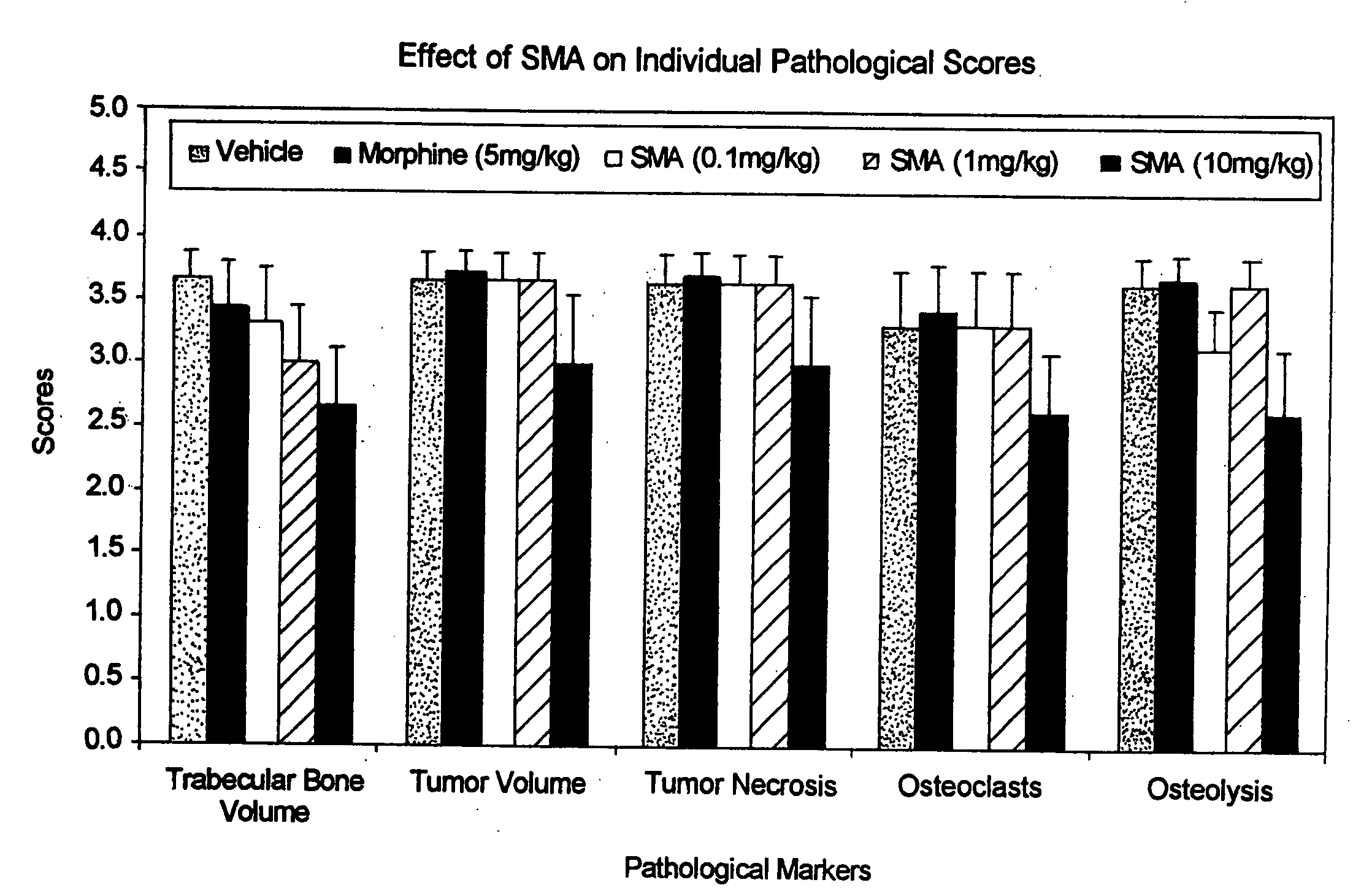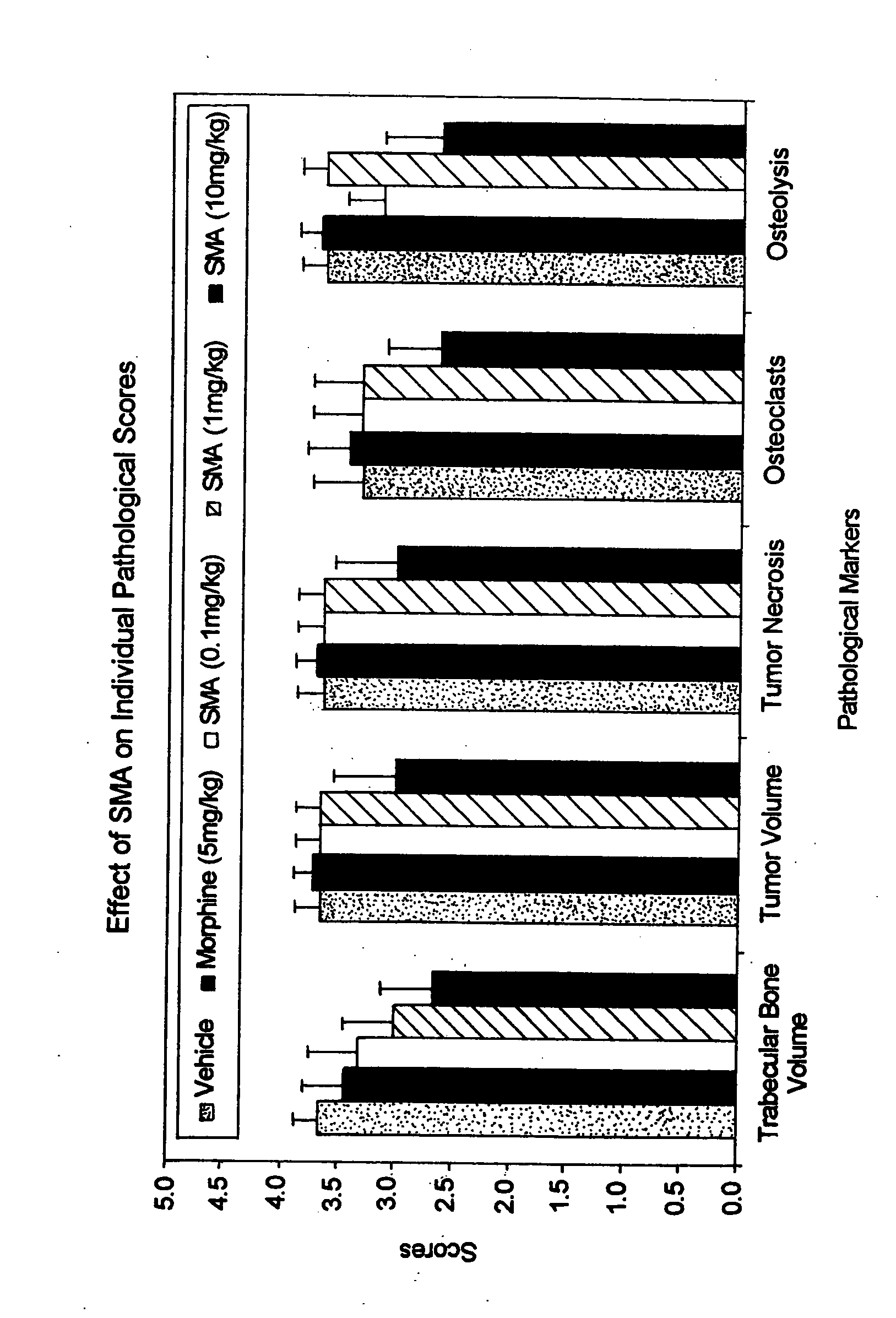Use of arsenic compounds for treatment of pain and inflammation
- Summary
- Abstract
- Description
- Claims
- Application Information
AI Technical Summary
Benefits of technology
Problems solved by technology
Method used
Image
Examples
example 1
Use of Animal Models to Test Analgesic Activity
[0074]Animal models for chemical-induced pain were used to determine the analgesic activity of various concentrations of sodium meta arsenite and arsenic trioxide.
[0075]Mouse Formalin Test. Sodium meta arsenite or arsenic trioxide was administered orally (PO) or intraperitoneally (IP), respectively, to groups of ten CD-1 (Crl.) derived male mice weighing 24+ / −2 g. Sodium meta arsenite and vehicle (distilled water) or arsenic trioxide and vehicle were each administered one hour before subplantar injection of formalin 0.02 ml, 2% solution). Reduction of the formalin-induced hind paw licking time recorded at five minute intervals during the following 0 to 35 minute period after formalin injection by 50% or more (≧50%) indicated significant analgesic activity. Statistical analysis was performed using One-way ANOVA followed by Dunnett's test for comparing results obtained with sodium meta arsenite or arsenic trioxide to those obtained with v...
example 2
Use of Animal Models to Test Anti-Inflammatory Activity of Sodium Meta Arsenite and Arsenic Trioxide
[0080]Sodium meta arsenite and arsenic trioxide were tested for possible protective effects against lipopolysaccharide-induced septic shock in mice.
[0081]LPS-Induced Pro-inflammatory Cytokine Production. Sodium meta arsenite was administered orally at 0.1, 1 and 10 mg / kg doses, one hour prior to challenge with lipopolysaccharide (LPS; 30 mg / kg IP; Escherechia coli 055:B5). Two hours after LPS challenge, 0.1 ml blood samples were taken from the mice via the retro-orbital and centrifuged to yield plasma for cytokine measurements by Luminex. After blood collection, mortality was monitored and recorded every 12 hours over a 3-day period. Reduction in mortality by 50 percent or more (≧50%) indicates significant protection. The results are shown in the table below:
[0082]Sodium Meta Arsenite:
RouteDose% ProtectionPO 10 mg / kg25PO1.0 mg / kg25PO0.1 mg / kg12Dexamehasone 21-acetatePO 3. mg / kg(75)
[00...
example 3
Immunosuppression Studies
[0088]Hyperplasia of popliteal lymph nodes (PLN) has been used as a dependable indicator of lymphatic system reaction in host-versus-graft studies. The heterotropic heart transplantation model in the rat has been used successfully to evaluate immunosuppressive agents. A combination of PLN hyperplasia assay and heart transplantation model was used to obtain information relating to the efficacy of host lymphocytes in both alloreactive proliferation and allorejection. The results show that sodium meta arsenite has immunosuppressive effects.
[0089]Heart transplantation. Donor hearts were transplanted into the recipient mouse as described (Chen et al., Transplantation, 56:661-666, 1993; Chen et al., The Journal of Immunology, 152:3107-3318, 1994). The transplanted donor hearts were checked every day and sodium meta arsenite was administered for two weeks or until the graft was rejected, whichever occurred first.
[0090]In the heart transplantation model, the higher ...
PUM
 Login to View More
Login to View More Abstract
Description
Claims
Application Information
 Login to View More
Login to View More - R&D
- Intellectual Property
- Life Sciences
- Materials
- Tech Scout
- Unparalleled Data Quality
- Higher Quality Content
- 60% Fewer Hallucinations
Browse by: Latest US Patents, China's latest patents, Technical Efficacy Thesaurus, Application Domain, Technology Topic, Popular Technical Reports.
© 2025 PatSnap. All rights reserved.Legal|Privacy policy|Modern Slavery Act Transparency Statement|Sitemap|About US| Contact US: help@patsnap.com


